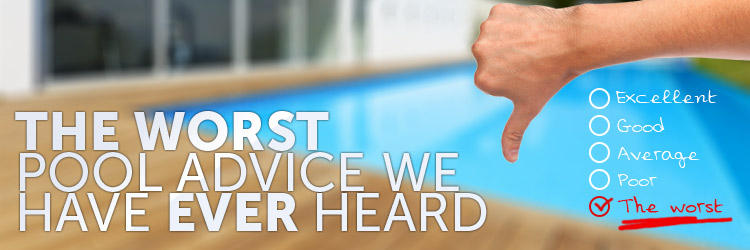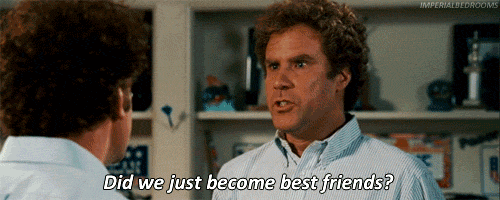Let’s face it, with access to the internet, a lot of jobs and skills that were once sought out and paid for have become jobs you can do yourself. With a little advice and a Youtube video, you can almost build anything on your own. Still, not all advice given is created equal nor should be treated equally. Unfortunately, in the pool industry, bad advice can sometimes mean hundreds of dollars out of your pocket and a lot of missed time out of your pool. Throughout the years we have encountered a lot of customers who have taken their share of bad advice. We wanted to share the top 5 with you in hopes you won’t make those same mistakes. Caveat Emptor!
“I was told I could just put the chlorine tablets in the skimmer or pump basket.”
I’m saddened to say that we encounter this issue at least five times every season and our response is always the same, “Please do NOT put your chlorine tablets into your skimmer or pump.” Your pump and filter are the two driving forces that keep your pool clean and healthy. Let’s say you decide to put your chlorine tablets, or “hockey pucks” as a lot of people like to call them, into your skimmer. Once your pump and filter turns off, the tablets keep dissolving in your skimmer, forming highly acidic water. Once the pump is turned back on, this same acidic water goes straight into the filter. This can compromise the internal parts of your filter – cartridges, o-rings, and gaskets – forcing you to replace them earlier than normally necessary.
Instead of putting chlorine tablets in your skimmer or pump, we recommend using a chlorinator. A chlorinator will automatically disperse chlorine into your pool according to an adjustable setting on the unit. Chlorinators work with your existing pump and filter and are usually very easy to install. Another option is a floating chlorinator which is just a plastic vessel that holds tablets and floats in the pool. Floating chlorinators are super cheap and can usually be found in local stores like Walmart. Whatever you do, though, please do not put chlorine tablets into your skimmer or pump!
“My pool guy told me I could run my pump a few hours a day…. but now my pool is green.”
Pool pumps should run on average between 8-10 hours a day. As a basic rule of thumb, you should be able to filter your entire pool within an 8-hour time frame. In other words, your entire pool (in gallons) should pass through the filter in this 8 hour period. If you are not giving your pump and filter enough time to properly clean the pool and keep the chemicals in flow, your pool will turn green. Not to mention, it might be unsafe for even recreational purposes.
As a pool owner, you need to become comfortable with certain pool calculations. If not for yourself, definitely as a means of double checking pool “professionals” who may steer you in the wrong direction. Here’s how you can calculate the minimum time you need to operate your pump
- Determine how many gallons of water is in your pool. (Pool’s length x Pool’s width x Pool’s average depth x 7.5)
- Figure out the pump’s gallon per minute (GPM) This information is typically listed on the pump label. Once you find this number, multiply that by 60 to get the gallons per hour.
- Divide the gallons per hour into the total gallons in your pool.
- This answer gives you the minimum hours needed to run your pump so that your entire pool is filtered properly.
So the next time someone recommends that you run your pump for “insert # of hours”, always refer back to the GPM of your pump. No one likes to swim in a dirty pool and no pool owner likes to spend additional money to fix something that was preventable from the start.
“My pool guy sold me a bigger pump than I had on before because he said the bigger the pump, the less I’ll have to run it.”
When it comes to pumps, bigger is not always better. A pump is limited by the plumbing size set up at your home and the maximum capacity your pool filter can handle. A higher horsepower (HP) means more power and energy is being used to pump the same amount of water, thus causing your energy bill to skyrocket. A higher horsepower draws more amps but does not move the water faster through your circulation system. Instead of reaping the benefits you thought you were getting by increasing your HP, you end up with a higher energy bill, a burnt-out motor, and an oversized pump you spent more money on than you wish you had.
If you need help trying to properly size your pool pump or want to verify if your current HP is accurate, then please check out our how to guide labeled How To Size A Pool Pump.
If you’re looking to save money, our advice is to switch to a dual speed or variable speed pump. By switching to one of these, you are able to operate your pump using less energy. You can operate your pump at the lower speeds during normal circulation and on high speed whenever you clean your pool. And who doesn’t like saving money, right? In short, bigger is not better when determining the horsepower for your pool pump. Over sizing is very common, but very easy to fix. We are always available to verify if your pump is oversized and if you are overspending.
“You can determine if your pool is clean by the smell of chemicals.”
If someone ever tells you this, take a step back, and go in the opposite direction. The smell of chemicals is not an indication of a clean pool, but just the opposite. A properly disinfected pool has no strong chemical smell. The strong smell common to many pools, especially public, is due to something called chloramines. Chloramines are the byproducts of chlorine’s reaction to contaminants brought into the pool by swimmers. These contaminants include perspiration, urine, body oils, and cosmetics.
Therefore, a strong chemical odor is actually an indication that the chlorine in the pool is working overtime due to the excess amount of contaminants and not an indication of it being clean.
“My pool guy told me I could use Vaseline (petroleum jelly) to lubricate my o-rings.”
You should never, ever use Vaseline or any petroleum-based lubricants for any of your o-rings. Most manufacturers recommend a silicone or a Teflon-based lubricant for all o-rings and gaskets. The oil composites of the petroleum jelly will cause the rubber to break down and will completely eat away your o-ring. Although o-rings range in size from really small to very large, never underestimate their power or the importance of their job. Using the wrong type of lubricant can cause leaks and ruin your system.












Leave a Reply